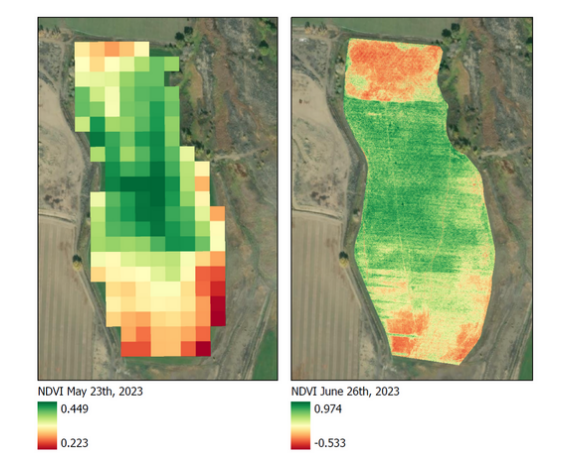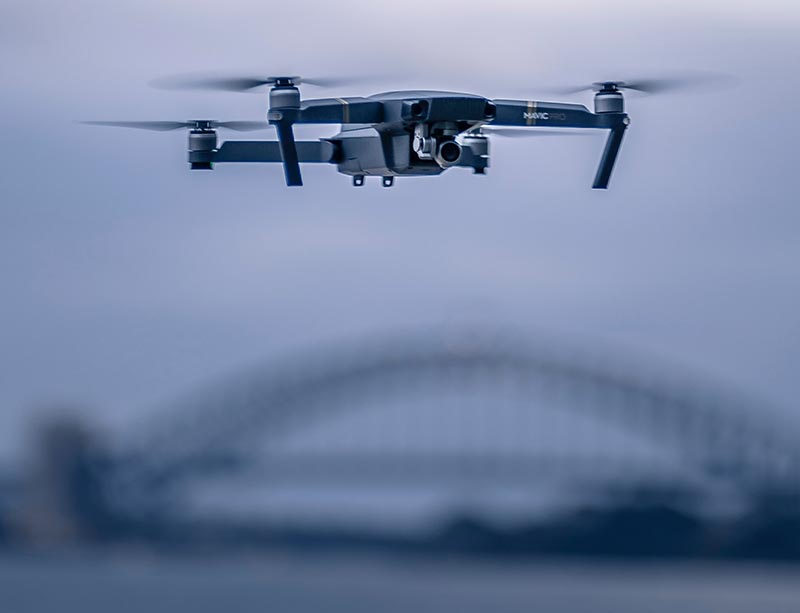By C. Mosso, P. Cabot, D. Dean, and T. Ballard
Revised by A. Olsen-Mikitowicz, J. Anderson, and E. Quiñonez
Print English Fact Sheet | Print Spanish Fact Sheet
Quick Facts…
- Using drones in agriculture can improve time and cost efficiency
- You need a remote pilot license (certification) to fly drones for non-recreational purposes
- To become certified, you must comply with eligibility criteria and pass the Small (UAG) exam
- A drone pilot license is good for two years
The use of small unmanned aircraft systems (sUAS) or drones in the agricultural sector is rapidly increasing due to the advantages over traditional technologies. From field inspection to crop health monitoring and agrochemical spraying, the use of drones improves time and cost efficiency while performing these and other agricultural tasks [1, 2, 3].
In particular, the use of drone based multispectral data to monitor crop aspects that are not visible to the human eye overcomes the limitations of satellite-borne data in terms of spatial and temporal resolution, allowing for better-informed decision making [4].
The aim of this fact sheet is to describe the necessary steps involved in the process of getting a license to fly a drone under the Federal Aviation Administration’s (FAA) Small UAS Rule (Part 107), making this information readily available for interested farmers. FAA’s Part 107 covers a spectrum of non-recreational uses for drones weighing less than 55 pounds. Drones weighing 55 pounds or more operate under Part 91 and require exemptions from several regulations in Parts 61, 91, and 137. The use of drones to dispense or spray substances is regulated under Part 137 and requires a different certification process. Parts 61, 91, and 137 are not addressed in this fact sheet.
Why is it important to get a drone pilot license?
If you intend to fly/are already flying drones in the U.S. for other than recreational purposes, then you must comply with Part 107 regulations (14 CFR Part 107). These apply to the use of drones for agricultural purposes.
Part 107 establishes the guidelines that regulate the registration, certification, and operation of UAS in the U.S. Among other things, these regulations establish that all non-recreational drone flight operations must be supervised by a certified drone pilot: The Remote Pilot in Command (RPIC). Only individuals who have passed Part 107 exam can qualify as the RPIC under the mentioned regulations.
The RPIC is responsible for verifying the correct and safe operation of the drone prior and during the flight and for ensuring compliance with regulations during the entirety of the flight duration. The RPIC is also responsible for carrying the required documentation under Part 107 and for making it available if required by the competent authority.
In addition, the RPIC is responsible for reporting drone accidents that result in damage to property or injury to people to the FAA. Flying a drone for non-recreational purposes without the direct supervision of a certified drone pilot is illegal and could result in onerous fines. Similarly, failure to register a drone if it is to be used for commercial purposes can result in regulatory and criminal penalties. The FAA’s civil penalties go up to $27,500, while criminal penalties can reach to $250,000 and/or imprisonment for up to three years.
How do I become a certified drone pilot?
To become a certified drone pilot under Part 107 regulations, you must:
- Comply with the eligibility criteria:
- Be at least 16 years old.
- Be proficient in English.
- Be in a physical and mental condition that allows flying drones safely.
- Pass the Unmanned Aircraft General – Small (UAG) exam.
- Obtain a Remote Pilot Certificate from the FAA.
The Remote Pilot Certificate is valid for 24 calendar months, after which it is necessary to complete FAA’s online recurrent training course (free). This will keep your Remote Pilot Certificate current. This certificate demonstrates proficient knowledge of the regulations, operating requirements, and procedures involved in safe drone flying.
The UAG exam is theoretical and includes the following topics:
- Small UAS regulations, limitations, and flight operations.
- Airspace: classification, operating requirements, and flight restrictions.
- Airport operations and interpretation of aeronautical charts.
- Weather: sources of information, interpretation of weather reports, and effects on UAS performance.
- Small UAS loading and performance.
- Emergency procedures and crew resource management.
- Radio communications.
- Physiological factors that affect pilots’ performance.
- Aeronautical decision-making and judgment.
- Maintenance and preflight inspection procedures.
- Operations at night.
| Topics | Percentage of items on exam |
| Regulations | 15-25% |
| Airspace & Requirements | 15-25% |
| Weather | 11-16% |
| Loading & Performance | 7-11% |
| Operations | 35-45% |
| Number of exam questions | 60 |
Even though some of these topics may seem unrelated to drone operations in agricultural contexts, that is not necessarily the case. Becoming knowledgeable about all the mentioned topics is not only necessary to pass the exam and access the drone pilot certificate: it will also significantly improve decision-making and safety in all drone operations.
For example, it is not uncommon to enter controlled airspace while monitoring agricultural fields with a drone. Going through the preparation process for Part 107 exam will give you the tools to properly manage these and other challenging situations.
Left: Single field NDVI calculated from Landsat 9 imagery at 30 meter spatial resolution. Right: Drone based NDVI from a DJI Phantom 4 of the same field with 5 cm spatial resolution. Figure credits: Clara
Mosso.
Study Materials
The FAA recommends the use of the following materials to prepare for Part 107 exam:
- Pilot’s Handbook of Aeronautical Knowledge (PHAK)
- Remote Pilot – Small Unmanned Aircraft Systems Study Guide
- Airman Certification Standards
- Part 107
- Other resources:
- UAS Ready Reference Guide
- Digital aeronautical charts
You can use these materials to prepare for the exam and study at your own pace. If you think you need more support to go through the required topics, there are currently different Part 107 exam preparation courses available for a fee. For example, Colorado State University offers the course EDLL 2400 – Online FAA Part 107 Drone Pilot Test Prep. For more information about this and other drone-related courses and resources available at CSU, contact CSU Drone Center.
What is the exam like?
After examining the study materials, the next step is to register for the exam:
- Follow the registration instructions in IACRA and get your FTN (FAA Tracking Number).
- Find a PSI test center near you and schedule an appointment for the Unmanned Aircraft General – Small (UAG) exam (you will need your FTN to complete this process). At the time this fact sheet was written (July 5th, 2023), the cost of the exam was $175 US dollars.
This exam is computer-based, multiple choice, and in person. It contains 60 questions and you will have 2 hours to complete it. You will be given a test supplement (“Airman Knowledge Testing Supplement for Sport Pilot, Recreational Pilot, Remote Pilot, and Private Pilot”) at the time of the exam. This supplement contains figures that you will need to understand and analyze to answer some of the questions. You can buy a printed copy to practice for the exam and get familiar with these figures, but you cannot bring your own copy of the supplement into the exam room. To pass the exam, you need a minimum score of 70%.
You can access practice exams through the PSI website. Each practice exam contains 46 questions similar to the ones that can be found in the UAG exam. You are given 1:30 hours to complete each practice exam. After providing your email, you will receive feedback on your performance on each practice exam: you will get the codes for the questions that you answered, including the ones that were answered incorrectly. You can then look for this codes in the Airman Certification Standards document to know which topics included in the practice test need to be reviewed. You can take as many practice exams as needed.
I passed the exam, now what?
After passing Part 107 exam, you must complete FAA Form 8710-13 for a remote pilot certificate through IACRA (you should already have an account, the one you created to obtain the FTN). A few days after submitting your application, you will receive a notification via email saying that your temporary remote pilot certificate is available for printing. Follow the instructions to print this certificate and carry it with you every time you fly your drone until you get the permanent certificate.
From this moment, your name will appear in the FAA’s airman registry . The temporary certificate is valid for up to 120 days after the issuance day or until the receipt of the permanent certificate. The permanent certificate will be sent to you via regular mail.
Final remarks
- The use of drone based data has multiple applications in the agricultural sector, offering the potential to enhance efficiency and enrich decision-making processes through improved data quality.
- Using the airspace to fly drones entails responsibilities. If you are flying/intend to fly drones for agricultural purposes, you are required to have a remote pilot certificate or be under direct supervision of a certified remote pilot. The FAA can issue you a fine if you are flying under Part 107 rules without the corresponding license or supervision.
- Being a certified drone pilot expands your drone use possibilities: it enables you to operate drones not only for recreational purposes but also for compensation and other objectives, including flying within controlled airspace upon securing the necessary authorization. It also allows you to request waivers from the FAA if an exception to the rules is required for certain flight missions.
References
[1] Ezenne, G. I., Jupp, L., Mantel, S. K., & Tanner, J. L. (2019). Current and potential capabilities of UAS for crop water productivity in precision agriculture. Agricultural Water Management, 218, 158–164. https://doi.org/10.1016/j.agwat.2019.03.034 [2] Jung, J., Maeda, M., Chang, A., Bhandari, M., Ashapure, A., & Landivar-Bowles, J. (2021). The potential of remote sensing and artificial intelligence as tools to improve the resilience of agriculture production systems. Current Opinion in Biotechnology, 70, 15–22. https://doi.org/10.1016/j.copbio.2020.09.003 [3] Merz, M., Pedro, D., Skliros, V., Bergenhem, C., Himanka, M., Houge, T., Matos-Carvalho, J. P., Lundkvist, H., Cürüklü, B., Hamrén, R., Ameri, A. E., Ahlberg, C., & Johansen, G. (2022). Autonomous UAS-Based Agriculture Applications: General Overview and Relevant European Case Studies. Drones, 6(5), Article 5. https://doi.org/10.3390/drones6050128[4] Hassler, S. C., & Baysal-Gurel, F. (2019). Unmanned Aircraft System (UAS) Technology and Applications in Agriculture.Agronomy,9(10), 618.
14 CFR Part 107: www.ecfr.gov/current/title-14/chapterI/subchapter-F/part-107
Penalties: www.faa.gov/faq/there-penalty-failing-register
Recurrent training course: www.faasafety.gov/gslac/ALC/CourseLanding.aspx?cID=677
Pilot’s Handbook of Aeronautical Knowledge (PHAK): www.faa.gov/regulations_policies/handbooks_manuals/aviation/phak
Remote Pilot – Small Unmanned Aircraft Systems Study Guide: www.faa.gov/sites/faa.gov/files/uas/resources/policy_library/remote_pilot_study_guide.pdf
Airman Certification Standards: www.faa.gov/sites/faa.gov/files/uas/resources/policy_library/uas_acs.pdf
UAS Ready Reference Guide: www.oregon.gov/aviation/Airports/Documents/2022-05-26_UAS%20Ref%20Guide%20(AJRB)_FINAL_CLEAN.pdf
Digital aeronautical charts: www.vfrmap.com/
EDLL 2400 – Online FAA Part 107 Drone Pilot Test Prep: www.online.colostate.edu/courses/EDLL/EDLL2400.dot
IACRA: www.iacra.faa.gov/IACRA
Find a PSI test center near you: www.faa.psiexams.com/faa/login
Test supplement: www.faa.gov/sites/faa.gov/files/training_testing/testing/supplements/sport_rec_private_akts.pdf
Practice exams:
www.faadim.psiexams.com/WebTest/Secure/login.aspx
FAA’s airman registry:
www.amsrvs.registry.faa.gov/airmeninquiry
Useful links:
https://www.faa.gov/uas/commercial_operators/become_a_drone_pilot









